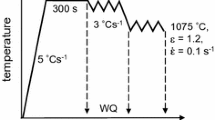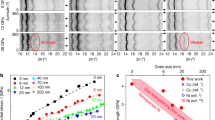Abstract
The objective of this study is to understand and quantify the role of the coincidence-site-lattice boundary (CSLB) population on creep deformation of Ni-16Cr-9Fe at 360 °C. It is hypothesized that an increase in the CSLB population decreases the annihilation rate of dislocations in the grain boundary, leading to an increase in the internal stress and a decrease in the effective stress. The result is a reduction in the creep strain rate. The role of CSLBs in deformation is, thus, to increase the internal stress by trapping run-in lattice dislocations at the grain boundaries as extrinsic grain boundary dislocations (EGBDs), creating backstresses on following dislocations rather than annihilating them, as in the case of high-angle boundaries (HABs). The hypothesis was substantiated by showing (1) that dislocation absorption kinetics differ substantially between a CSLB and an HAB, and (2) that the CSLB fraction strongly affects the internal stress in the solid. Dislocation absorption kinetics were measured by comparing EGBD density in transmission electron microscopy (TEM). Results showed that CSLBs contain an EGBD density which is 3 times higher than HABs at 1.25 pct strain. Internal stress was measured by the stress dip test and was found to be ≈ 30 MPa higher in the CSLB-enhanced sample. Steady-state creep rates of Ni-16Cr-9Fe in 360 °C argon were also found to be strongly affected by the grain boundary character distribution. Increasing the CSLB fraction by approximately a factor of 2 resulted in a decrease in steady-state creep rates by a factor of 8 to 26 in coarse-grain (330 µm) samples and a factor of 40 to 66 in small-grain (35 µm) samples. It is postulated that annihilation of EGBDs only occurs at triple lines where at least two HABs intersect. By using a geometric relationship to evaluate the probability of EGBDs annihilating at a triple line, the model predicts a non-linear dependence of the creep rate with CSLB fraction, yielding excellent correlation with measurement. The model provides a physical basis for measurements which show that increasing the CSLB fraction by only moderate amounts can greatly reduce the steady-state creep rate in Ni-16Cr-9Fe.
Similar content being viewed by others
References
K. Norring and J. Engstrom: 1985 Workshop on Primary-Side Stress Corrosion Cracking of PWR Steam Generator Tubing, A.R. McIlree, ed., EPRI, Palo Alto, CA, Report No. NP-5158, 1987, paper no. 3.
A.K. Agrawal and G. Frieling: 1987 Workshop on Secondary-Side Intergranular Corrosion Mechanisms, EPRI, Palo Alto, CA, Report No. NP-4458, Mar. 1988.
G.P. Airey: 3rd Int. Symp. on Environmental Degradation of Materials in Nuclear Power Systems-Water Reactors, NACE, Houston, TX, 1984, pp. 462–78.
A.P. Sutton: Int. Met. Rev., 1984, vol. 29, pp. 377–402.
L.S. Shvindlerman and B.B. Straumal: Acta Metall., 1985, vol. 33, pp. 1735–49.
G. Palumbo, P.J. King, P.C. Lichtenberger, K.T. Aust, and U. Erb: Mater. Res. Soc. Symp. Proc., 1992, vol. 238, pp. 311–316.
K.T. Aust, U. Erb, and G. Palumbo: Mechanical Properties and Deformation Behavior of Materials Having Ultra-Fine Microstructure, NATO ASI Series, Kluwer, Hingham, MA, 1993, p. 107.
P.J. Goodhew: Met. Sci. J., 1979, vol. 13, pp. 108–17.
D. Bouchet and L. Priester: Scripta Metall., 1987, vol. 21, pp. 475–78.
L. Priester: Rev. Phys. Appl., 1989, vol. 21, pp. 419–38.
H. Kokawa, T. Watanabe, and S. Karashima: Phil. Mag. A, 1981, vol. 40, pp. 1239–54.
Don and S. Majumdar: Acta Metall., 1986, vol. 34, pp. 961–67.
T. Watanabe: J. Phys., 1988, vol. 5, pp. 507–19.
D.C. Crawford and G.S. Was: Metall. Trans. A, 1992, vol. 23A, pp. 1195–1206.
K.T. Aust, U. Erb, and G. Palumbo: Mater. Sci. Eng., 1994, vol. A176, pp. 329–34.
G.S. Was, J.K. Sung, and T.M. Angeliu: Metall. Trans., 1992, vol. 23A, pp. 3343–59.
G.S. Was, T.M. Angeliu, and J.K. Sung: Paper presented at the Alloy 600 Experts Meeting, Warrenton, VA, sponsored by the Electric Power Research Institute, Palo Alto, CA, Apr. 6–9, 1993.
T.M. Angeliu: Ph.D. Thesis, The University of Michigan, Ann Arbor, MI, 1993.
T. Watanabe, S.I. Kimura, and S. Karashima: Phil. Mag., 1984, vol. 49A, pp. 845–64.
K.J. Kurzydlowski, R.A. Varin, and W. Zielinski: Acta Metall., 1984, vol. 32, pp. 71–78.
A.H. King: Scripta Metall., 1985, vol. 19, pp. 1517–21.
L.C. Lim and R. Raj: Acta Metall., 1985, vol. 33, pp. 1577–83.
D.C. Crawford and G.S. Was: J. Electron Micro. Techn., 1991, vol. 19, pp. 345–60.
V. Thaveeprungsriporn, J.F. Mansfield, and G.S. Was: J. Mater. Res., 1994, vol. 9 (7), pp. 1887–94.
D.G. Brandon: Acta Metall., 1966, vol. 14, pp. 1479–84.
V. Thaveeprungsriporn: Ph.D. Thesis, The University of Michigan, Ann Arbor, MI, 1996.
P. Hirsch, A. Howie, R.B. Nicholson, D.W. Pashley, and M.J. Whelan: Electron Microscopy of Thin Crystals, R.E. Krieger Publishing Co., Malabar, FL, 1977, p. 416.
V. Randle: Microtexture Determination and Its Applications, The Institute of Materials, London, 1992.
V. Randle: The Measurement of Grain Boundary Geometry, Institute of Physics Publishing, Bristol, 1993.
J. Cadek: Mater. Sci. Eng., 1987 vol. 94, pp. 79–92.
H. Kokawa, T. Watanabe, and S. Karashima: Phil. Mag. A, 1981, vol. 44 (6), pp. 1239–54.
H. Kokawa, T. Watanabe, and S. Karashima: J. Mater. Sci., 1983, vol. 18, pp. 1183–94.
T. Johannesson and A. Thölén: Met. Sci. J., 1972, vol. 6, pp. 189–94.
P.R. Howell, J.O. Nilsson, and G.L. Dunlop: Phil. Mag. A, 1978, vol. 38 (1), pp. 39–47.
W.A.T. Clark and D.A. Smith: J. Mater. Sci., 1979, vol. 14, pp. 776–88.
R.C. Pond and D.A. Smith: Phil. Mag. A, 1977, vol. 36, pp. 353–66.
P.H. Pumphrey: Scripta Metall., 1975, vol. 9, pp. 151–77.
D.J. Dingley and R.C. Pond: Acta Metall., 1979, vol. 27, pp. 667–82.
W. Lojkowski: Acta Metall. Mater., 1991, vol. 39 (8), pp. 1891–99.
W. Blum: Phys. Status. Solid B, 1971, vol. 45, pp. 561–71.
J.W. Wyrzykowski and M.W. Grabski: Phil. Mag. A, 1986, vol. 53 (4), pp. 505–20.
J. Cadek: in Creep in Metallic Materials, Elsevier Science, New York, NY, 1988.
H. Mecking and K. Lucke: Scripta Metall., 1970, vol. 4, pp. 427–32.
R.A. Varin and K. Tangri: Scripta Metall., 1980, vol. 14, pp. 337–40.
N.L. Peterson: in Grain Boundary Structure and Kinetics, R.W. Balluffi, ed., ASM, Metals Park, OH, 1980, pp. 209–38.
S. Sangal and K. Tangri: Metall. Trans. A, 1989, vol. 20A, pp. 479–84.
H.J. Frost and M.F. Ashby: in Deformation Mechanism Maps: The Plasticity and Creep of Metals and Ceramics, Pergamon Press, Oxford, United Kingdom, 1982.
A.K. Mukherjee, J.E. Bird, and J.E. Dorn: ASM Trans. Q., 1969, vol. 62, p. 155.
T.H. Alden: Acta Metall., 1969, vol. 17, p. 1435.
M.W. Grabski: J. Phys., 1988, vol. C5, pp. 497–506.
W.A. Swiatnicki and M.W. Grabski: Acta Metall., 1986, vol. 34, p. 817.
J.L. Hertzberg and G.S. Was: Scripta Metall. Mater., 1995, vol. 33, pp. 1193–99.
F.N. Rhines, K.R. Craig, and R.T. DeHoff: Metall. Trans., 1974, vol. 5, pp. 413–25.
L.E. Murr and S.H. Wang: Res Mech., 1982, vol. 4, pp. 237–74.
V. Thaveeprungsriporn, T.M. Angeliu, D.J. Paraventi, J.L. Hertzberg, and G.S. Was: 6th Int. Symp. on Environmental Degredation of Materials in Nuclear Power Systems-Water Reactors, San Diego, CA, Aug. 1993, TMS, Warrendale, PA, 1993, pp. 721–27.
Author information
Authors and Affiliations
Rights and permissions
About this article
Cite this article
Thaveeprungsriporn, V., Was, G.S. The role of coincidence-site-lattice boundaries in creep of Ni-16Cr-9Fe at 360 °C. Metall Mater Trans A 28, 2101–2112 (1997). https://doi.org/10.1007/s11661-997-0167-6
Received:
Issue Date:
DOI: https://doi.org/10.1007/s11661-997-0167-6




